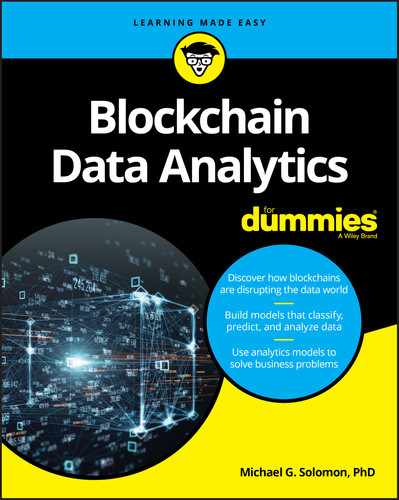Get ahead of the curve—learn about big data on the blockchain Blockchain came to prominence as the disruptive technology that made cryptocurrencies work. Now, data pros are using blockchain technology for faster real-time analysis, better data security, and more accurate predictions. Blockchain Data Analytics For Dummies is your quick-start guide to harnessing the potential of blockchain. Inside this book, technologists, executives, and data managers will find information and inspiration to adopt blockchain as a big data tool. Blockchain expert Michael G. Solomon shares his insight on what the blockchain is and how this new tech is poised to disrupt data. Set your organization on the cutting edge of analytics, before your competitors get there! Discover how blockchains are disrupting the data world with this exciting title in the trusted For Dummies line!
Table of Contents
- Cover
- Introduction
- Part 1: Intro to Analytics and Blockchain
- Chapter 1: Driving Business with Data and Analytics
- Deriving Value from Data
- Understanding and Satisfying Regulatory Requirements
- Predicting Future Outcomes with Data
- Changing Business Practices to Create Desired Outcomes
- Chapter 2: Digging into Blockchain Technology
- Exploring the Blockchain Landscape
- Understanding Primary Blockchain Types
- Aligning Blockchain Features with Business Requirements
- Examining Blockchain Use Cases
- Chapter 3: Identifying Blockchain Data with Value
- Exploring Blockchain Data
- Categorizing Common Data in a Blockchain
- Examining Types of Blockchain Data for Value
- Aligning Blockchain Data with Real-World Processes
- Chapter 4: Implementing Blockchain Analytics in Business
- Aligning Analytics with Business Goals
- Surveying Options for Your Analytics Lab
- Installing the Blockchain Client
- Installing the Test Blockchain
- Installing the Testing Environment
- Installing the IDE
- Chapter 5: Interacting with Blockchain Data
- Exploring the Blockchain Analytics Ecosystem
- Adding Anaconda and Web3.js to Your Lab
- Writing a Python Script to Access a Blockchain
- Building a Local Blockchain to Analyze
- Part 2: Fetching Blockchain Chain
- Chapter 6: Parsing Blockchain Data and Building the Analysis Dataset
- Comparing On-Chain and External Analysis Options
- Integrating External Data
- Identifying Features
- Building an Analysis Dataset
- Chapter 7: Building Basic Blockchain Analysis Models
- Identifying Related Data
- Making Predictions of Future Outcomes
- Analyzing Time-Series Data
- Chapter 8: Leveraging Advanced Blockchain Analysis Models
- Identifying Participation Incentive Mechanisms
- Managing Deployment and Maintenance Costs
- Collaborating to Create Better Models
- Part 3: Analyzing and Visualizing Blockchain Analysis Data
- Chapter 9: Identifying Clustered and Related Data
- Analyzing Data Clustering Using Popular Models
- Implementing Blockchain Data Clustering Algorithms in Python
- Discovering Association Rules in Data
- Determining When to Use Clustering and Association Rules
- Chapter 10: Classifying Blockchain Data
- Analyzing Data Classification Using Popular Models
- Implementing Blockchain Classification Algorithms in Python
- Determining When Classification Fits Your Analytics Needs
- Chapter 11: Predicting the Future with Regression
- Analyzing Predictions and Relationships Using Popular Models
- Implementing Regression Algorithms in Python
- Determining When Regression Fits Your Analytics Needs
- Chapter 12: Analyzing Blockchain Data over Time
- Analyzing Time Series Data Using Popular Models
- Implementing Time Series Algorithms in Python
- Determining When Time Series Fits Your Analytics Needs
- Part 4: Implementing Blockchain Analysis Models
- Chapter 13: Writing Models from Scratch
- Interacting with Blockchains
- Connecting to a Blockchain
- Examining Blockchain Client Languages and Approaches
- Chapter 14: Calling on Existing Frameworks
- Benefitting from Standardization
- Focusing on Analytics, Not Utilities
- Leveraging the Efforts of Others
- Chapter 15: Using Third-Party Toolsets and Frameworks
- Surveying Toolsets and Frameworks
- Comparing Toolsets and Frameworks
- Chapter 16: Putting It All Together
- Assessing Your Analytics Needs
- Choosing the Best Fit
- Managing the Blockchain Project
- Part 5: The Part of Tens
- Chapter 17: Ten Tools for Developing Blockchain Analytics Models
- Developing Analytics Models with Anaconda
- Writing Code in Visual Studio Code
- Prototyping Analytics Models with Jupyter
- Developing Models in the R Language with RStudio
- Interacting with Blockchain Data with web3.py
- Extract Blockchain Data to a Database
- Accessing Ethereum Networks at Scale with Infura
- Analyzing Very Large Datasets in Python with Vaex
- Examining Blockchain Data
- Preserving Privacy in Blockchain Analytics with MADANA
- Chapter 18: Ten Tips for Visualizing Data
- Checking the Landscape around You
- Leveraging the Community
- Making Friends with Network Visualizations
- Recognizing Subjectivity
- Using Scale, Text, and the Information You Need
- Considering Frequent Updates for Volatile Blockchain Data
- Getting Ready for Big Data
- Protecting Privacy
- Telling Your Story
- Challenging Yourself!
- Chapter 19: Ten Uses for Blockchain Analytics
- Accessing Public Financial Transaction Data
- Connecting with the Internet of Things (IoT)
- Ensuring Data and Document Authenticity
- Controlling Secure Document Integrity
- Tracking Supply Chain Items
- Empowering Predictive Analytics
- Analyzing Real-Time Data
- Supercharging Business Strategy
- Managing Data Sharing
- Standardizing Collaboration Forms
- Index
- About the Author
- Advertisement Page
- Connect with Dummies
- End User License Agreement
